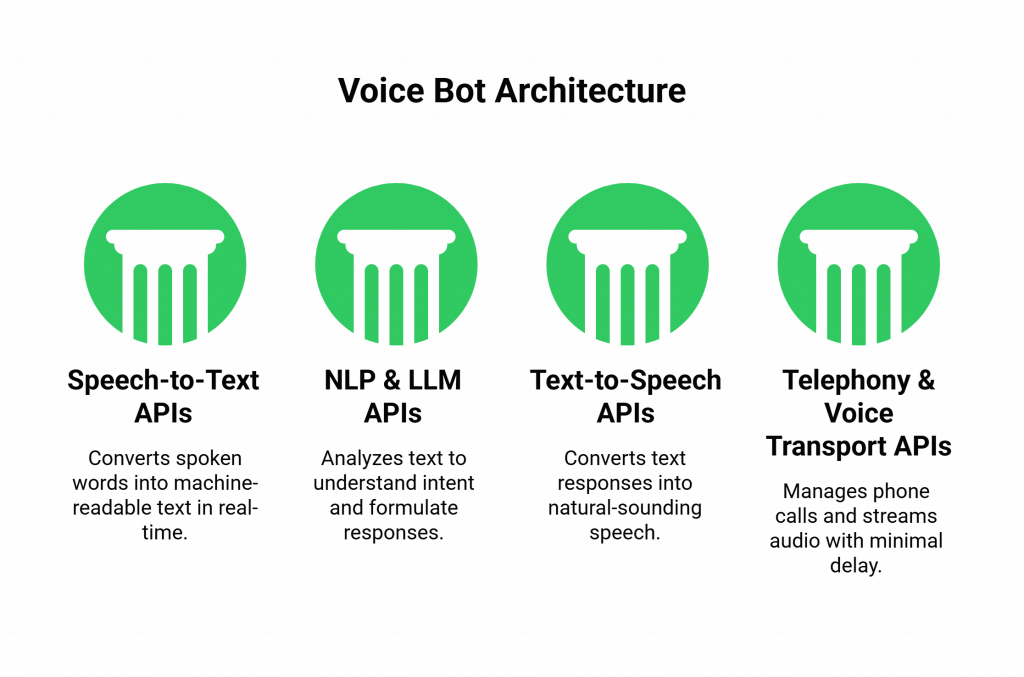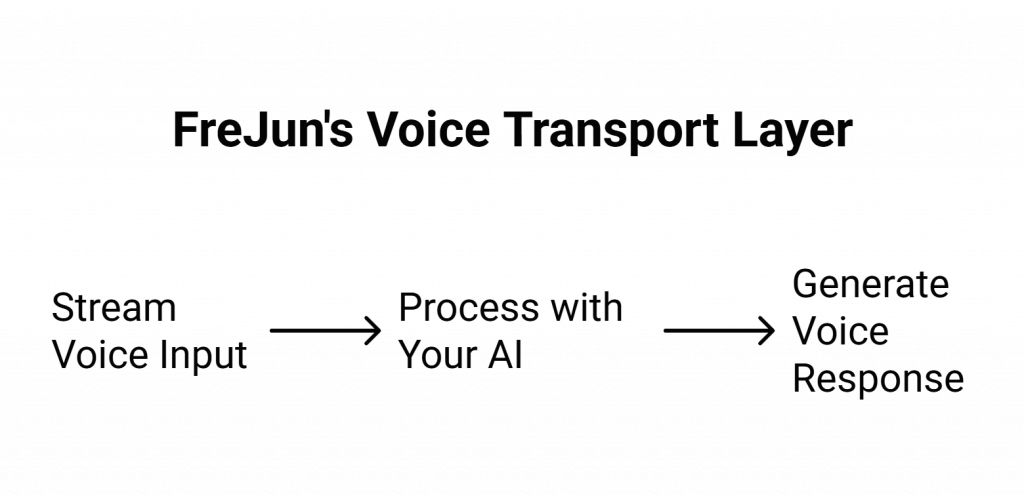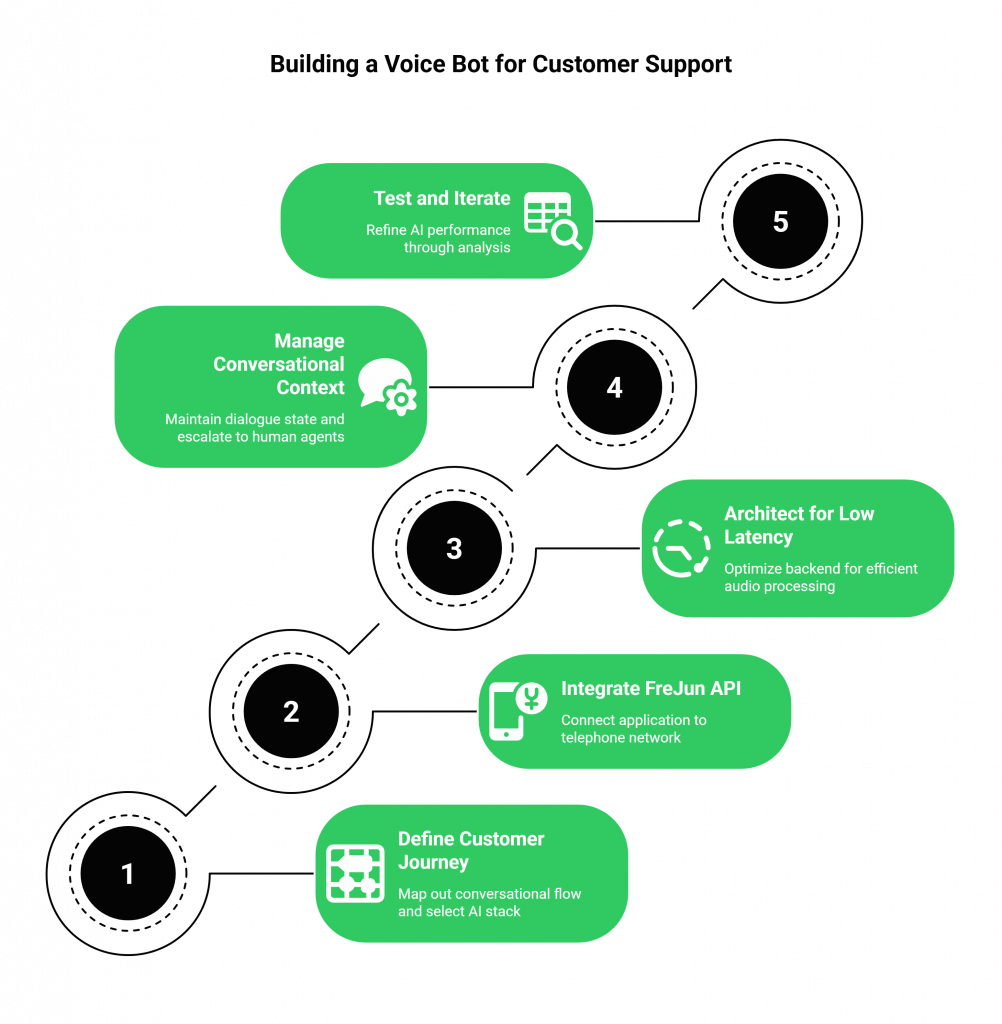Modern customer support demands more than fast answers, it demands real-time conversations. As voice emerges as the most natural interface, businesses are racing to deploy voicebots that can handle actual phone calls. But stitching together Speech-to-Text, LLMs, and Text-to-Speech is not enough. The missing piece is infrastructure. FreJun provides a production-grade voice transport layer that connects your AI stack to live telephony, reliably and in real time. This guide shows how to build a voicebot that sounds sharp, thinks fast, and actually works.
Table of contents
- The Real Challenge of Building a Voice Bot for Customer Support
- Anatomy of a Modern Voice Bot: The Core API Pillars
- The Developer’s Dilemma: Why Managing Voice Infrastructure Is So Hard
- FreJun: The Intelligent Voice Transport Layer for Your AI
- Building a Voice Bot: The Old Way vs. The FreJun Way
- Blueprint for a Production-Grade Voice Bot Using FreJun
- Final Thoughts: Your AI Is Ready to Talk. Give It the Right Voice.
- Frequently Asked Questions (FAQ)
The Real Challenge of Building a Voice Bot for Customer Support
Every forward-thinking business wants to build an AI Voice Bot for Customer Support. The promise is alluring: 24/7 availability, instant responses, and the ability to free up human agents for high-value, complex issues. To achieve this, development teams turn to a suite of powerful APIs to handle everything from understanding human speech to generating a lifelike voice in response.
But a critical, often underestimated, challenge lies hidden beneath the surface of AI models and language processing. The real bottleneck isn’t just finding the right AI, it’s managing the complex, real-time voice infrastructure that connects your customer to that AI.
Stitching together separate APIs for Speech-to-Text (STT), AI logic, and Text-to-Speech (TTS) is one thing. Ensuring that the audio stream from a phone call is delivered to these services with near-zero latency, absolute clarity, and carrier-grade reliability is a monumental engineering task. This is where most voice bot projects fail, resulting in awkward pauses, broken conversations, and a frustrating customer experience. The problem isn’t the AI; it’s the plumbing.
Anatomy of a Modern Voice Bot: The Core API Pillars
To appreciate the complexity, it’s essential to understand the distinct API layers that work in concert to power a seamless conversational experience. A high-performing Voice Bot for Customer Support is not a single piece of software but a sophisticated ecosystem of specialized services.

Pillar 1: Speech-to-Text (STT) APIs — The Ears
The journey begins the moment a customer speaks. STT APIs are responsible for capturing the raw audio from a phone call and transcribing it into machine-readable text. This process must be instantaneous and highly accurate to form the basis of the entire interaction.
- Function: Converts spoken words into text.
- Requirement: Real-time processing and high accuracy across different languages and accents.
Pillar 2: Natural Language Processing (NLP) & LLM APIs — The Brain
Once the customer’s query is in text format, NLP and Large Language Model (LLM) APIs take over. This is the core intelligence of the bot. These APIs analyze the text to decipher the user’s intent, understand the context of the conversation, and determine the appropriate response or action. This could involve querying a database, accessing a CRM, or formulating a helpful answer.
- Function: Understands intent, manages dialogue, and formulates responses.
- Requirement: Deep contextual understanding and the ability to integrate with business systems for personalized interactions.
Pillar 3: Text-to-Speech (TTS) APIs — The Voice
After the AI has decided what to say, TTS APIs like FeJun’s API convert that text response back into audible, natural-sounding speech. The quality of the TTS directly impacts the user’s perception of the bot, making the difference between a robotic IVR and a genuinely helpful, human-like agent.
- Function: Converts text into spoken audio.
- Requirement: Low-latency generation of clear, lifelike, and expressive speech.
Pillar 4: Telephony & Voice Transport APIs — The Nervous System
This is the invisible yet foundational layer that ties everything together. Telephony APIs manage the phone call itself,initiating it, receiving it, and handling the raw media stream. A voice transport layer is responsible for streaming the audio from the caller to your STT service and from your TTS service back to the caller with minimal delay. This layer is the “nervous system” that ensures the ears, brain, and voice can communicate in perfect sync. Without a robust transport layer, even the most advanced AI will feel slow and unresponsive.
Also Read: WhatsApp Chat Handling Strategies for Medium‑Sized Enterprises in Israel
The Developer’s Dilemma: Why Managing Voice Infrastructure Is So Hard
While many platforms offer APIs for STT, NLP, and TTS, developers are often left to solve the incredibly difficult problem of voice transport themselves. This involves navigating a minefield of telecommunications complexity. Here are the primary challenges:
- Minimizing Latency: The round-trip journey,from the customer speaking, to STT transcription, to NLP processing, to TTS generation, and back to the customer’s ear,must happen in milliseconds. Any delay creates unnatural pauses that destroy the conversational flow. Managing this latency across multiple API calls is a significant hurdle.
- Real-Time Media Streaming: Handling real-time audio streams over the public internet is notoriously difficult. Developers must contend with issues like jitter (variability in packet arrival time), packet loss, and varying network conditions, all of which degrade audio quality.
- Telephony Integration: Connecting a web-based AI to the global telephone network requires deep expertise in protocols like SIP (Session Initiation Protocol), managing phone numbers, and ensuring interoperability with carriers worldwide.
- Scalability and Reliability: Building an infrastructure that can handle thousands of concurrent calls with 99.99%+ uptime is a full-time job for a team of specialized engineers. A single point of failure can bring your entire customer support operation to a halt.
Developers are forced to become telephony experts instead of focusing on what truly matters: building a smart, helpful, and effective AI assistant.
FreJun: The Intelligent Voice Transport Layer for Your AI
This is precisely where FreJun transforms the development process. FreJun is not another all-in-one AI bot platform. We don’t provide STT, TTS, or LLM services. Instead, we provide the single most important and complex piece of the puzzle: the voice transport layer.

We handle the complex voice infrastructure so you can focus on building your AI.
Our architecture is designed from the ground up for one purpose: to serve as a reliable, low-latency bridge between the telephone network and your AI applications. We provide the “plumbing” so you can bring your own best-in-class AI components. Here’s how it works in three simple steps:
- Stream Voice Input: Our API captures real-time, low-latency audio from any inbound or outbound call. This raw audio stream is sent directly to the STT service of your choice.
- Process with Your AI: With the transcribed text, your application maintains full control over the dialogue state. You connect to your preferred LLM and other business systems to generate the perfect response. FreJun maintains a stable connection while your backend does the thinking.
- Generate Voice Response: You pipe the audio output from your TTS service directly to our API. FreJun streams it back over the call with minimal latency, completing the conversational voice bot loop flawlessly.
Also Read: Business Communication Solutions for Calling Vietnam from the United States
Building a Voice Bot: The Old Way vs. The FreJun Way
Choosing the right architectural approach is critical. A platform that abstracts away the right complexities can accelerate development and dramatically improve the final product.
| Aspect | The Traditional “All-in-One” API Approach | The FreJun Approach (Voice Transport Layer) |
| Infrastructure Management | Developers must manage complex telephony integrations or are locked into a provider’s limited infrastructure. | Voice and telephony infrastructure is fully managed by FreJun, engineered for high availability and scale. |
| AI Model Flexibility | Often locked into the platform’s proprietary STT, NLP, and TTS models, limiting choice and innovation. | Bring Your Own AI. FreJun is model-agnostic, allowing you to connect any AI, LLM, or voice service you choose. |
| Latency Control | Latency is often a “black box” determined by the platform’s internal architecture, with limited room for optimization. | The entire stack is optimized for low-latency media streaming, giving you a transparent and reliable transport channel. |
| Development Focus | Significant time is spent on telephony protocols, call state management, and troubleshooting connectivity issues. | Developers focus 100% on what they do best: building the AI logic and crafting a superior conversational experience. |
| Scalability & Reliability | Scaling is dependent on the provider’s architecture. Reliability can be a concern if voice is not their core competency. | Built on resilient, geographically distributed infrastructure designed for enterprise-grade security and reliability. |
| Control Over Logic | Conversational context and dialogue management may be handled by the platform, reducing developer control. | Your application maintains full control over the dialogue state and conversational context from end to end. |
Blueprint for a Production-Grade Voice Bot Using FreJun
With FreJun handling the transport layer, building a world-class Voice Bot for Customer Support becomes a streamlined, logical process.

Step 1: Define the Customer Journey and Select Your AI Stack
Before writing a line of code, map out the ideal conversational flow. What are the most common queries? What information will the bot need? Based on this, select your preferred “best-in-class” APIs for STT, NLP, and TTS.
Step 2: Integrate the FreJun Voice API
Using our developer-first SDKs, connect your application to FreJun Voice API. This is your gateway to the telephone network. Our comprehensive documentation makes it easy to configure phone numbers and set up the handlers for incoming calls and real-time audio streams.
Step 3: Architect Your Application for Low Latency
Structure your backend to process the audio streams efficiently. Because FreJun provides a stable, low-latency connection, you can focus on optimizing the processing time of your AI stack. The transport-related delays are already minimized.
Step 4: Manage Conversational Context on Your Backend
Since FreJun acts purely as a transport layer, your application remains the single source of truth for the conversation. You track the dialogue state, manage context, and decide when and how to escalate to a human agent, giving you complete control over the user experience. This is crucial for building a truly intelligent Voice Bot for Customer Support.
Step 5: Test, Analyze, and Iterate
A great Voice Bot for Customer Support is never truly “finished.” The reliable connection provided by FreJun ensures you receive clean audio and data, which is essential for analysis. Track metrics like intent recognition rates, task completion, and customer sentiment to continuously refine your AI’s performance.
Also Read: WhatsApp Chat Handling Strategies for Medium-Sized Enterprises
Final Thoughts: Your AI Is Ready to Talk. Give It the Right Voice.
The potential for AI to revolutionize customer support is undeniable. However, you can only unlock that potential when the underlying technology works seamlessly. Your customers won’t care how advanced your LLM is if delays and poor audio quality ruin the conversation.
Stop wrestling with SIP trunks, jitter buffers, and real-time media streaming protocols. This is a solved problem. By partnering with FreJun, you offload the entire voice infrastructure burden to a team of experts. This frees up your development talent to work on the AI logic that delivers real business value and differentiates you from the competition.
The strategic advantage is clear: faster time-to-market, superior customer experiences, and the flexibility to use the best AI technology available, today and tomorrow. Your AI is smart. It’s time to give it a voice that is just as powerful.
Frequently Asked Questions (FAQ)
No. FreJun is a model-agnostic platform. We provide the voice transport infrastructure that allows you to connect any AI, Large Language Model (LLM), Speech-to-Text (STT), or Text-to-Speech (TTS) service of your choice. You bring your own intelligence; we make sure it can talk.
FreJun specializes in being the best-in-class voice transport layer. We focus exclusively on solving the complex challenges of real-time telephony and media streaming. All-in-one platforms bundle STT, AI, and TTS services, which can limit your flexibility and control. With FreJun, you get an enterprise-grade foundation and the freedom to choose the best AI components for your specific needs.
Our entire technology stack, from our carrier interconnections to our APIs, is engineered and optimized for real-time media streaming. We provide a stable, high-performance channel between the end-user and your backend AI services, minimizing the transport-related delays that cause awkward pauses in conversation.
Absolutely. FreJun is designed to work as the “plumbing” that connects a phone call to your services. Our API makes it simple to receive the incoming audio stream for your STT service and send the outgoing audio stream from your TTS service back to the caller.
We offer a developer-first experience, complete with comprehensive client-side and server-side SDKs to accelerate development. Furthermore, our dedicated integration support team is available to assist you, from pre-integration planning to post-launch optimization, ensuring your journey from concept to production is smooth and successful.
